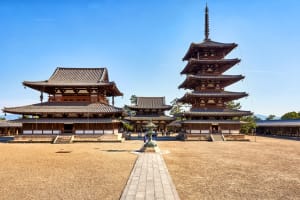
Todai-ji is a Buddhist temple complex located in the city of Nara, Japan. It was founded in the 8th century during the Nara period and is considered one of the most significant temples in Japan. The main hall of Todai-ji, called the Daibutsuden, houses the world's largest bronze statue of the Buddha Vairocana, also known as the Great Buddha of Nara.
The Daibutsuden was originally constructed in the early 8th century and was one of the largest wooden buildings in the world at the time. However, it has been destroyed and rebuilt several times throughout its history due to fires and earthquakes. The current building, which dates back to the 17th century, is only two-thirds the size of the original.
The Great Buddha statue is housed inside the Daibutsuden and stands at over 15 meters (49 feet) tall. It was completed in 752 and is a representation of the Buddhist principle of cosmic balance. The statue is surrounded by other large bronze sculptures of bodhisattvas, guardians, and heavenly kings.
Todai-ji is also home to several other important buildings, including the Hokke-do, a smaller temple that houses a statue of Yakushi Nyorai, the Buddha of healing. There is also a museum on the temple grounds that houses various artifacts and treasures from Todai-ji's long history.
The temple is surrounded by the Nara Park, which is home to hundreds of deer that are considered sacred messengers in Japanese culture. Visitors to the temple can purchase special crackers to feed the deer and interact with them up close.
Todai-ji is a popular tourist destination and is a UNESCO World Heritage site. It is considered one of the most iconic and important Buddhist temples in Japan and is a testament to the country's rich cultural heritage.
Explore Near Todai-ji
Discover 5 attractions, 5 cities, and 3 airports within 75km. Perfect for planning day trips, finding connecting flights, or discovering new destinations to explore during your visit.
Nearby Attractions & Places to Visit
5 destinations within 1.0km - 22.5km from your location





Nearby Cities Worth Exploring
5 destinations within 3.2km - 12.8km from your location
Airports Near Todai-ji
3 destinations within 38.2km - 61.8km from your location